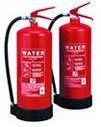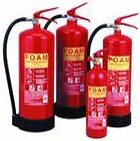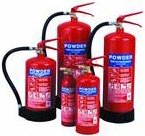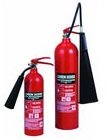Fire and Safety Services
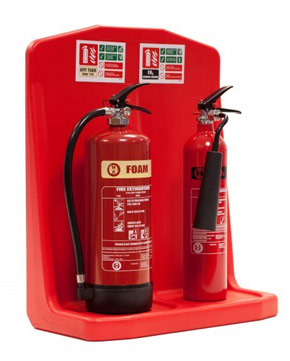
Fire Extinguishers

We supply and service all types of fire extinguishers,
please call us for a no obligation quotation.
How to identify how many extinguishers are required.
Please note that this section is only provided for guidance only and we would strongly recommend that a qualified fire engineer visits your premises to identify the types and quantities of fire extinguishers you may require.
It is generally considered that all types of premises will have Class A materials present and the example below calculates the minimum quantity of portable fire extinguishers required. Where specific risks such as fuel or electric switchgear are also present then additional extinguishers will be required to cover this.
British Standard 5306-8:2012 identifies that the minimum quantity of extinguishers with an A rating should be calculated as follows:
(a) Any storey with a floor area less than or equal to 400m2, should be covered by at least two extinguishers with a class A rating having a combined minimum total fire rating of 26A;
(b) Any storey with a floor area exceeding 400m2, should be covered by at least two extinguishers with a class A rating having a minimum total fire rating of 0.065 x floor area of the storey (in square metres).
For example if we took a warehouse that was 1680m2 in ground floor area there would be a minimum requirement of: Ground floor: 0.065 x 1680 = 110A
Ground floor: 110A ÷ 13A = 8.46 i.e. 9 extinguishers
If there was a small 1st floor office less than 400m2 = 26A If we took a standard 6 litre water extinguisher having a rating of 13A then we would require the following number of extinguishers:
1st floor: 26A ÷ 13A = 2 extinguishers
The remaining classes of fire are less easy to calculate due to a number of additional issues to be considered therefore, it is recommended that specialist advice is sought. It should be noted that many extinguishers are dual rated so whilst covering a specific issue will also contribute towards the total A rating; for instance a standard 6 litre wet chemical extinguisher which has a rating of 13A/75F would cover 0.11m2 of class F risk as well as contributing 13A towards the overall A rating so effectively reducing by one the number of water extinguishers required.
Extinguishers should be sited near to the fire hazard concerned but not so near as to be inaccessible or place the operator in undue danger. Normally extinguishers should be located:
- In conspicuous positions on brackets, floor stands or within cabinets;
- Where they would be readily seen by persons following an escape route;
- Near to room exits, corridors, stairways, lobbies and landings;
- Ideally at similar positions on multi-floor premises;
- So that extinguishers covering specific risks are reached first by a prospective user;
- With a maximum travel distance from the site of the fire to an extinguisher of:
- Class A or C fire risks = 30 metres
- Class B, F or electrical fire risks = 10 metres
- Class D = on a case by case basis by expert advice
If you have any concerns over the quantity, types or serviceability of the fire extinguishers at your workplace then Red Fire would be happy to provide free advice.
Water extinguishers
Suitable for Class A type fires involving combustible materials such as wood, paper and textiles. Water is a fast and efficient means of extinguishing these materials. Extinguishes by having a rapid cooling effect, so that insufficient heat remains to sustain burning and continuous ignition ceases.
Use by aiming the discharge nozzle at the base of the fire.
HAZARDS: Not suitable for use on electrical appliances or fuel/fat fires
Foam spray extinguishers
(AFFF - Aqueous Film Forming Foam), are ideal for multi-risk situations where both Class A combustible materials and Class B flammable liquid risks are likely to be found, or where Class B risks present a direct hazard. Foam spray extinguishers are especially suitable for Class B fires involving flammable liquids such as oils, spirits, greases, fats and certain plastics.
The blanketing effect of foam spray gives rapid flame knock down which smothers the flame and thus prevents re-ignition of flammable vapours by sealing the surface of the solution.
HAZARDS: Not suitable for use on electrical appliances.
Powder extinguishers
Suitable for use on Class A, B and also Class C type fires involving flammable gases such as propane and butane. Powder extinguishers are also highly effective for electrical hazards.
This multi-purpose powder interferes with the combustion process and provides rapid-fire knock down.
HAZARDS: Safe on electrical equipment although does not penetrate the spaces in equipment easily and the fire may ignite. Does not cool the fire very well and care must be taken to ensure the fire does not flare up again. Use by aiming the discharge nozzle at the base of the flames and with a rapid sweeping motion drive the fire to the far edge until all the flames are out.
Visibility will be reduced when used within a building.
Carbon dioxide extinguishers
Suitable for fires involving flammable liquids and electrical hazards. The non-corrosive and non-conductive qualities of CO2 make it an ideal choice for dealing with fires involving electrical equipment and machinery.
HAZARDS: A carbon dioxide fire extinguisher does not cool the fire. Turn off the electricity to the appliance if safe to do so. Try to avoid holding on to the discharge horn as this will become extremely cold.
Use by aiming the discharge nozzle at the base of the flames and sweep the jet across the area of the fire. Extinguishes by displacing the oxygen in the air.
Fumes from CO2 extinguishers can be harmful if used in confined spaces. Ventilate the area as soon as the fire is under control.
Fire blankets
Made of fire resistant materials. Fire blankets are particularly useful for smothering fat pan fires. Leave the blanket on the fire for at least 30 minutes, do not remove, leave that task to the fire service.
Red Fire and Safety can also service your extinguishers - find out more

